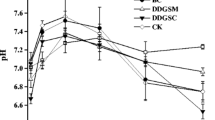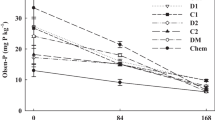Abstract
Recycling urban nutrients onto farmland has the potential to improve phosphorus (P) supply and yields on P-depleted organic farms, reduce global reliance on non-renewable mined phosphate rock, and reduce environmental contamination caused by excess P. Three recycled nutrient sources (struvite from municipal wastewater, frass from insect-processed food waste, and anaerobic digestate of food waste) were compared with common conventional (mono-ammonium phosphate, MAP) and organic (livestock compost) P sources in field experiments in spring wheat and forage hay on a high-pH (8.1–8.3) soil. Experiments were conducted on a low-P site (3 mg kg−1 Olsen P) over 2 years with conventional- and organically-selected wheat genotypes. In wheat, P uptake increased by 172%, 130%, 92%, and 43% compared to an unfertilized treatment for frass, MAP, compost, and digestate, respectively. Frass, MAP, compost and digestate increased grain yield by 41%, 40%, 29%, and 20%, respectively. Struvite did not significantly increase yields or P uptake. For both P uptake and grain yield, frass and compost treatments were similar to the “conventional” MAP treatment, while digestate and struvite treatments were lower than MAP. An organically-selected wheat genotype produced greater biomass but similar yield compared to a conventional genotype, demonstrating some genotype advantage. In the forage-hay crop, cumulative P uptake increased by 124%, 99%, 86%, 73%, and 65% compared to an unfertilized treatment for frass, MAP, digestate, struvite, and compost, respectively. Yield increased only in the second year of the trial, by 136%, 125%, 112%, 94%, and 79% for frass, struvite, MAP, digestate, and compost, respectively. The recycled nutrient sources varied in their efficacy in the two crops and relative to other nutrient sources, but all showed some potential to supply P and improve yields on a P-depleted soil.





Similar content being viewed by others
Availability of data and materials
Not applicable.
Code availability
Not applicable.
References
Akinremi OO, Armisenrenew N, Kashem MA, Janzen HH (2003) Evaluation of analytical methods for total phosphorus in organic amendments. Commun Soil Sci Plant Anal 34:2981–2991. https://doi.org/10.1081/CSS-120025220
Bachmann S, Uptmoor R, Eichler-Löbermann B (2016) Phosphorus distribution and availability in untreated and mechanically separated biogas digestates. Sci Agric 73:9–17. https://doi.org/10.1590/0103-9016-2015-0069
Bhuiyan MIH, Mavinic DS, Beckie RD (2007) A solubility and thermodynamic study of struvite. Environ Technol 28:1015–1026. https://doi.org/10.1080/09593332808618857
Bolland M, Baker M (1988) High phosphorus concentrations in seed of wheat and annual medic are related to higher rates of dry matter production of seedlings and plants. Aust J Exp Agric 28:765. https://doi.org/10.1071/EA9880765
Brod E, Øgaard AF, Hansen E et al (2015) Waste products as alternative phosphorus fertilisers part I: inorganic P species affect fertilisation effects depending on soil pH. Nutr Cycl Agroecosyst 103:167–185. https://doi.org/10.1007/s10705-015-9734-1
Case SDC, Jensen LS (2019) Nitrogen and phosphorus release from organic wastes and suitability as bio-based fertilizers in a circular economy. Environ Technol 40:701–715. https://doi.org/10.1080/09593330.2017.1404136
Čičková H, Newton GL, Lacy RC, Kozánek M (2015) The use of fly larvae for organic waste treatment. Waste Manag 35:68–80. https://doi.org/10.1016/j.wasman.2014.09.026
Clark RB (1983) Plant genotype differences in the uptake, translocation, accumulation, and use of mineral elements required for plant growth. Plant Soil 72:175–196. https://doi.org/10.1007/BF02181957
Degryse F, Baird R, da Silva RC, McLaughlin MJ (2017) Dissolution rate and agronomic effectiveness of struvite fertilizers—effect of soil pH, granulation and base excess. Plant Soil 410:139–152. https://doi.org/10.1007/s11104-016-2990-2
Entz MH, Guilford R, Gulden R (2001) Crop yield and soil nutrient status on 14 organic farms in the eastern portion of the northern Great Plains. Can J Plant Sci 81:351–354. https://doi.org/10.4141/P00-089
Entz MH, Kirk AP, Carkner M et al (2018) Evaluation of lines from a farmer participatory organic wheat breeding program. Crop Sci 58:2433–2443. https://doi.org/10.2135/cropsci2018.04.0241
European Commision (2015) Communication from the Commission to the European Parliament, the Council, the European Economic and Social Committee and the Committee of the Regions: closing the loop—An EU action plan for the Circular Economy. Brussels
Frossard E, Skrabal P, Sinaj S et al (2002) Forms and exchangeability of inorganic phosphate in composted solid organic wastes. Nutr Cycl Agroecosystems 62:103–113. https://doi.org/10.1023/A:1015596526088
Gagnon B, Demers I, Ziadi N et al (2012) Forms of phosphorus in composts and in compost-amended soils following incubation. Can J Soil Sci 92:711–721. https://doi.org/10.4141/cjss2012-032
Gosling P, Shepherd M (2005) Long-term changes in soil fertility in organic arable farming systems in England, with particular reference to phosphorus and potassium. Agric Ecosyst Environ 105:425–432. https://doi.org/10.1016/j.agee.2004.03.007
Grant CA, Flaten DN (2019) 4R management of phosphorus fertilizer in the Northern Great Plains. J Environ Qual 48:1356. https://doi.org/10.2134/jeq2019.02.0061
Grant CA, Flaten DN, Tomasiewicz DJ, Sheppard SC (2001) The importance of early season phosphorus nutrition. Can J Plant Sci 81:211–224. https://doi.org/10.4141/P00-093
Hargreaves JC, Adl MS, Warman PR (2008) A review of the use of composted municipal solid waste in agriculture. Agric Ecosyst Environ 123:1–14. https://doi.org/10.1016/j.agee.2007.07.004
Hertzberger AJ, Cusick RD, Margenot AJ (2020) A review and meta-analysis of the agricultural potential of struvite as a phosphorus fertilizer. Soil Sci Soc Am J 84:653–671. https://doi.org/10.1002/saj2.20065
Jarvie HP, Sharpley AN, Flaten D et al (2015) The pivotal role of phosphorus in a resilient water–energy–food security nexus. J Environ Qual 44:1049–1062. https://doi.org/10.2134/jeq2015.01.0030
Kebli H, Sinaj S (2017) Agronomic potential of a natural fertiliser based on fly larvae frass. Agrar Schweiz 8:88–95
Kibler KM, Reinhart D, Hawkins C et al (2018) Food waste and the food–energy–water nexus: a review of food waste management alternatives. Waste Manag 74:52–62. https://doi.org/10.1016/j.wasman.2018.01.014
Knight JD, Buhler R, Leeson JY, Shirtliffe SJ (2010) Classification and fertility status of organically managed fields across Saskatchewan, Canada. Can J Soil Sci 90:667–678. https://doi.org/10.4141/CJSS09082
Li B, Boiarkina I, Young B et al (2018) Prediction of future phosphate rock: a demand based model. J Environ Inform 31:41–53. https://doi.org/10.3808/jei.201700364
Ma Y, Liu Y (2019) Turning food waste to energy and resources towards a great environmental and economic sustainability: an innovative integrated biological approach. Biotechnol Adv. https://doi.org/10.1016/j.biotechadv.2019.06.013
Manitoba Agricultural Services Corporation (2018) Variety market share information. www.masc.mb.ca/masc.nsf/sar_varieties_2018.pdf. Accessed 26 Apr 2019
McDonald CE (1977) Methods of protein analysis and variation in protein results. Farm Res 34:3–7
Möller K, Müller T (2012) Effects of anaerobic digestion on digestate nutrient availability and crop growth: a review. Eng Life Sci 12:242–257. https://doi.org/10.1002/elsc.201100085
Möller K, Oberson A, Bünemann EK et al (2018) Improved phosphorus recycling in organic farming: navigating between constraints. Adv Agron 147:159–237. https://doi.org/10.1016/bs.agron.2017.10.004
Nicksy J, Entz MH (2021) Recycled nutrients as a phosphorus source for Canadian organic agriculture: a perspective. Can J Soil Sci 101:571–580. https://doi.org/10.1139/cjss-2021-0014
Nicksy J, Amiro B, Entz M (2021) Recycled nutrients supply phosphorus and improve ryegrass yields on phosphorus depleted soil. Can J Soil Sci. https://doi.org/10.1139/CJSS-2021-0004
Nkoa R (2014) Agricultural benefits and environmental risks of soil fertilization with anaerobic digestates: a review. Agron Sustain Dev 34:473–492. https://doi.org/10.1007/s13593-013-0196-z
Ramphisa PD, Collins PH, Bair EK, Davenport RJ (2020) Corn biomass, uptake and fractionation of soil phosphorus in five soils amended with organic wastes as P fertilizers. J Plant Nutr 43:335–353. https://doi.org/10.1080/01904167.2019.1683194
Reimer M, Hartmann TE, Oelofse M et al (2020) Reliance on biological nitrogen fixation depletes soil phosphorus and potassium reserves. Nutr Cycl Agroecosyst 118:273–291. https://doi.org/10.1007/s10705-020-10101-w
Rose TJ, Rengel Z, Ma Q, Bowden JW (2009) Crop species differ in root plasticity response to localised P supply. J Plant Nutr Soil Sci 172:360–368. https://doi.org/10.1002/jpln.200800031
Schmidt JH, Weedon O, Finckh MR (2018) Management histories of wheat composite cross populations (CCPs) drive yield in two tillage systems. In: Ba J, Dennenmoser D, Finckh MR (eds) Symposium on breeding for diversificaton. Kassel University Press GmbH, Witzenhausen, pp 48–50
Schneider KD, Thiessen Martens JR, Zvomuya F et al (2019) Options for improved phosphorus cycling and use in agriculture at the field and regional scales. J Environ Qual 48:1247–1264. https://doi.org/10.2134/jeq2019.02.0070
Setti L, Francia E, Pulvirenti A et al (2019) Use of black soldier fly (Hermetia illucens (L.), Diptera: Stratiomyidae) larvae processing residue in peat-based growing media. Waste Manag 95:278–288. https://doi.org/10.1016/j.wasman.2019.06.017
Sharpley A, Moyer B (2000) Phosphorus forms in manure and compost and their release during simulated rainfall. J Environ Qual 29:1462–1469. https://doi.org/10.2134/jeq2000.00472425002900050012x
Sikora LJ, Enkiri NK (2005) Comparison of phosphorus uptake from poultry litter compost with triple superphosphate in codorus soil. Agron J 97:668–673. https://doi.org/10.2134/agronj2004.0008
Strong WM, Soper RJ (1974) Phosphorus utilization by flax, wheat, rape, and buckwheat from a band or pellet-like application. I. Reaction zone root proliferation. Agron J 66:601–605. https://doi.org/10.2134/agronj1974.00021962006600050002x
Thiessen Martens JR, Entz MH, Schneider KD et al (2021) Response of organic grain and forage crops to struvite application in an alkaline soil. Agron J. https://doi.org/10.1002/agj2.20943
Veneklaas EJ, Lambers H, Bragg J et al (2012) Opportunities for improving phosphorus-use efficiency in crop plants. New Phytol 195:306–320. https://doi.org/10.1111/j.1469-8137.2012.04190.x
Wainaina S, Awasthi MK, Sarsaiya S et al (2020) Resource recovery and circular economy from organic solid waste using aerobic and anaerobic digestion technologies. Bioresour Technol. https://doi.org/10.1016/j.biortech.2020.122778
Welsh C, Tenuta M, Flaten DN et al (2009) High yielding organic crop management decreases plant-available but not recalcitrant soil phosphorus. Agron J 101:1027–1035. https://doi.org/10.2134/agronj2009.0043
Woodard HJ, Bly A (1998) Relationship of nitrogen management to winter wheat yield and grain protein in South Dakota. J Plant Nutr 21:217–233. https://doi.org/10.1080/01904169809365397
Zvomuya F, Helgason BL, Larney FJ et al (2006) Predicting phosphorus availability from soil-applied composted and non-composted cattle feedlot manure. J Environ Qual 35:928–937. https://doi.org/10.2134/jeq2005.0409
Acknowledgements
The authors thank D. Flaten for advice on field design, F. Zvomuya for assistance with statistics and design, J. Slater for useful discussions about food systems and nutrient recycling, A. Buckley for lab analyses, the Natural Systems Agriculture lab group for field work assistance, Enterra Feed Corporation for supplying the frass, and Ostara Nutrient Recovery Technologies Inc for supplying the struvite. This work was conducted on Treaty 1 territory, the traditional territory of Anishinaabeg, Cree, Oji-Cree, Dakota, and Dene Peoples, and the homeland of the Métis Nation.
Funding
Jessica Nicksy was supported by the University of Manitoba Graduate Fellowship, and the Natural Sciences and Engineering Research Council CGS-M fellowship. The work was supported by the Organic Federation of Canada, the Organic Science Cluster III Program of Agriculture and Agrifood Canada, and Ostara Nutrient Recovery Technologies.
Author information
Authors and Affiliations
Corresponding author
Ethics declarations
Conflict of interest
The authors declare no conflict of interest.
Additional information
Publisher's Note
Springer Nature remains neutral with regard to jurisdictional claims in published maps and institutional affiliations.
Supplementary Information
Below is the link to the electronic supplementary material.
Rights and permissions
About this article
Cite this article
Nicksy, J., Amiro, B. & Entz, M. Recycled nutrients supply phosphorus for organically-managed wheat and forage crops. Nutr Cycl Agroecosyst 123, 137–151 (2022). https://doi.org/10.1007/s10705-022-10212-6
Received:
Accepted:
Published:
Issue Date:
DOI: https://doi.org/10.1007/s10705-022-10212-6




